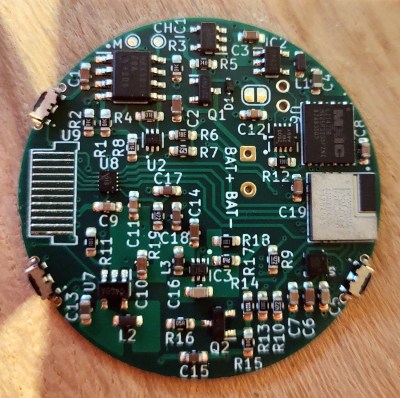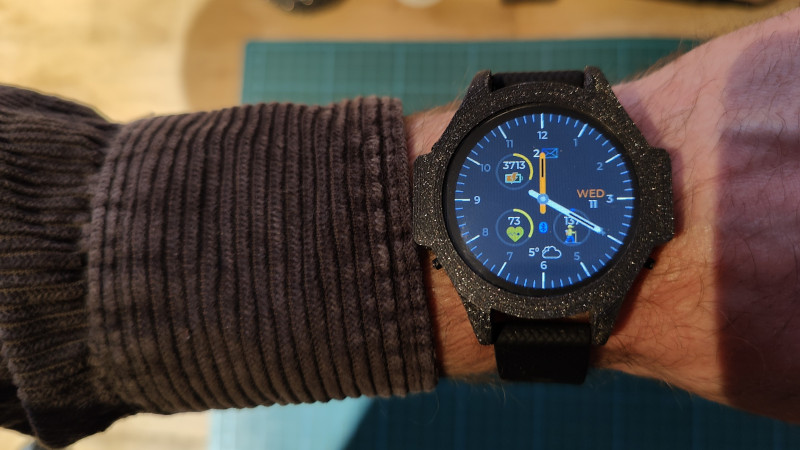We say it often, but it’s worth repeating: this is the Golden Age of making and hacking. Between powerful free and open source software, low-cost PCB production, and high resolution 3D printers that can fit on your desk, a dedicated individual has everything they need to make their dream gadget a reality. If you ever needed a reminder of this fact, just take a look at the ZSWatch.
 When creator [Jakob Krantz] says he built this MIT-licensed smart watch from scratch, he means it. He designed the 4-layer main board, measuring just 36 mm across, entirely in KiCad. He wrote every line of the firmware, and even designed the 3D printable case himself. This isn’t some wearable development kit he got off of AliExpress and modified — it’s all built from the ground up, and all made available to anyone who might want to spin up their own version.
When creator [Jakob Krantz] says he built this MIT-licensed smart watch from scratch, he means it. He designed the 4-layer main board, measuring just 36 mm across, entirely in KiCad. He wrote every line of the firmware, and even designed the 3D printable case himself. This isn’t some wearable development kit he got off of AliExpress and modified — it’s all built from the ground up, and all made available to anyone who might want to spin up their own version.
The star of the show is the nRF52833 SoC, which is paired with a circular 1.28″ 240×240 IPS TFT display. The screen doesn’t support touch, so there’s three physical buttons on the watch for navigation. Onboard sensors include a LIS2DS12 MEMS accelerometer and a MAX30101EFD capable of measuring heartrate and blood oxygen levels, and there’s even a tiny vibration motor for haptic feedback. Everything’s powered by a 220 mAh Li-Po battery that [Jakob] says is good for about two days — afterwards you can drop the watch into its matching docking station to get charged back up.
As for the software side of things, the watch tethers to a Android application over Bluetooth for Internet access and provides the expected functions such as displaying the weather, showing notifications, and controlling music playback. Oh, and it can tell the time as well. The firmware was made with extensibility in mind, and [Jakob] has provided both a sample application and some basic documentation for would-be ZSWatch developers.
While an unquestionably impressive accomplishment in its current form, [Jakob] says he’s already started work on a second version of the watch. The new V2 hardware will implement an updated SoC, touch screen, and an improved charging/programming connector. He’s also looking to replace the 3D printed case for something CNC milled for a more professional look.
The ZSWatch actually reminds us quite a bit of the Open-SmartWatch project we covered back in 2021, in that the final result looks so polished that the average person would never even take it for being DIY. We can’t say that about all the smartwatches we’ve seen over the years, but there’s no question that the state-of-the-art is moving forward for this kind of thing in the hobbyist space.















Kickstarter?
Selling things on Kickstarter required alot of work, I’m working on easier to build version, maybe I can sell some to interested people, but no plan to vretse something bigger.
good job,Looking forward to your new version, I want to make one myself.
Thanks, I did put up a link in the README to sign up when I finish the v2, or you can use “follow” on the repository to get notified when I release it.
Impressive. What surprised me is two days from 220mAh for nRF52833 – should be two weeks or even two months with BLE connectivity enabled all the time depending on screen/cpu usage. Two days means the SoC does not sleep at all.
There is some bug, after some SW debugging I right now suspect a PCB bug. I did not debug it very much yet what causes too high current consumption, as writing the SW was more appealing :) I think there are some current leaks. I designed it to be very low power and only the screen should consume any considerable power.
I like it but I’m disappointed they didn’t use a “memory-in-pixel” display because now the display is going to eat that battery.
You got a link to a memory-in-pixel display with a non-DSI interface and for $5 (like the display used here)?
Got a 2eur SmartWatch on Ali based on Freqchip chipset, found a gcc sdk on Github. If anyone wants to help to get something running on there:
https://github.com/zoobab/FR801xH
Well, there are tons of these random chinese BLE chips, what is a chance for buying same watch in a month or two or a year? How long before the chip itself and its manufacturer is gone?
According to https://www.freqchip.com/fr801xh it is Cortex M3 with 48K sram and 512K flash, good but not that great.
Wow, that is impressive. If anyone has a run of the PCB assembled, throw it on Tindie or something.
I’m very impressed that he managed to design this project without resorting to microscopic components. 0603 passives and no BGAs, looks very doable with tweezers and a hot plate.
Well, maybe except for U8, a 0.4mm pitch uQFN. But there seems to be enough room for a slightly bigger alternative.
I did mount it by hand with tweezers and hot plate, it was a bit of a pain, but managed at last, the only problematic one is the ANNA-B1 module which has 0.650mm pitch, I had to build 3 complete PCBs until I had no shorts below the ANNA-B1 module (nRF52833).
This is why I’m redesigning v2 with another module which will be easier to manually mount.
I solderid it like that, but for me it was not “very” doable hehe, it was a bit of a pain and took me 3 tries to get everything correctly soldered. But all fails was due to shorts below the nRF52833 module. This is why I’m doing changes in v2 to make it easier to hand solder.
Wow, amazing job, it looks great! The SW must have taken a lot of effort to implement from scratch!
Oh please someone port this clockface to it https://somethingorotherwhatever.com/wobble-clock/